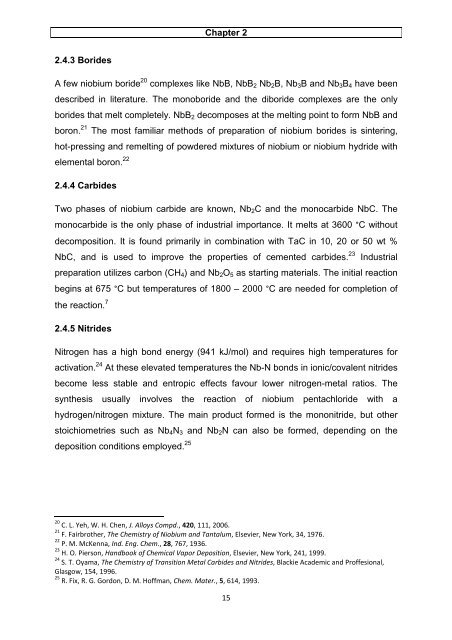A solution and solid state study of niobium complexes University of ...
A solution and solid state study of niobium complexes University of ...
A solution and solid state study of niobium complexes University of ...
You also want an ePaper? Increase the reach of your titles
YUMPU automatically turns print PDFs into web optimized ePapers that Google loves.
2.4.3 Borides<br />
Chapter 2<br />
A few <strong>niobium</strong> boride 20 <strong>complexes</strong> like NbB, NbB2 Nb2B, Nb3B <strong>and</strong> Nb3B4 have been<br />
described in literature. The monoboride <strong>and</strong> the diboride <strong>complexes</strong> are the only<br />
borides that melt completely. NbB2 decomposes at the melting point to form NbB <strong>and</strong><br />
boron. 21 The most familiar methods <strong>of</strong> preparation <strong>of</strong> <strong>niobium</strong> borides is sintering,<br />
hot-pressing <strong>and</strong> remelting <strong>of</strong> powdered mixtures <strong>of</strong> <strong>niobium</strong> or <strong>niobium</strong> hydride with<br />
elemental boron. 22<br />
2.4.4 Carbides<br />
Two phases <strong>of</strong> <strong>niobium</strong> carbide are known, Nb2C <strong>and</strong> the monocarbide NbC. The<br />
monocarbide is the only phase <strong>of</strong> industrial importance. It melts at 3600 °C without<br />
decomposition. It is found primarily in combination with TaC in 10, 20 or 50 wt %<br />
NbC, <strong>and</strong> is used to improve the properties <strong>of</strong> cemented carbides. 23 Industrial<br />
preparation utilizes carbon (CH4) <strong>and</strong> Nb2O5 as starting materials. The initial reaction<br />
begins at 675 °C but temperatures <strong>of</strong> 1800 – 2000 °C are needed for completion <strong>of</strong><br />
the reaction. 7<br />
2.4.5 Nitrides<br />
Nitrogen has a high bond energy (941 kJ/mol) <strong>and</strong> requires high temperatures for<br />
activation. 24 At these elevated temperatures the Nb-N bonds in ionic/covalent nitrides<br />
become less stable <strong>and</strong> entropic effects favour lower nitrogen-metal ratios. The<br />
synthesis usually involves the reaction <strong>of</strong> <strong>niobium</strong> pentachloride with a<br />
hydrogen/nitrogen mixture. The main product formed is the mononitride, but other<br />
stoichiometries such as Nb4N3 <strong>and</strong> Nb2N can also be formed, depending on the<br />
deposition conditions employed. 25<br />
20<br />
C. L. Yeh, W. H. Chen, J. Alloys Compd., 420, 111, 2006.<br />
21<br />
F. Fairbrother, The Chemistry <strong>of</strong> Niobium <strong>and</strong> Tantalum, Elsevier, New York, 34, 1976.<br />
22<br />
P. M. McKenna, Ind. Eng. Chem., 28, 767, 1936.<br />
23<br />
H. O. Pierson, H<strong>and</strong>book <strong>of</strong> Chemical Vapor Deposition, Elsevier, New York, 241, 1999.<br />
24<br />
S. T. Oyama, The Chemistry <strong>of</strong> Transition Metal Carbides <strong>and</strong> Nitrides, Blackie Academic <strong>and</strong> Pr<strong>of</strong>fesional,<br />
Glasgow, 154, 1996.<br />
25<br />
R. Fix, R. G. Gordon, D. M. H<strong>of</strong>fman, Chem. Mater., 5, 614, 1993.<br />
15
















